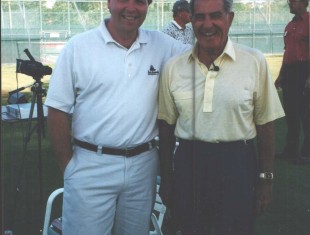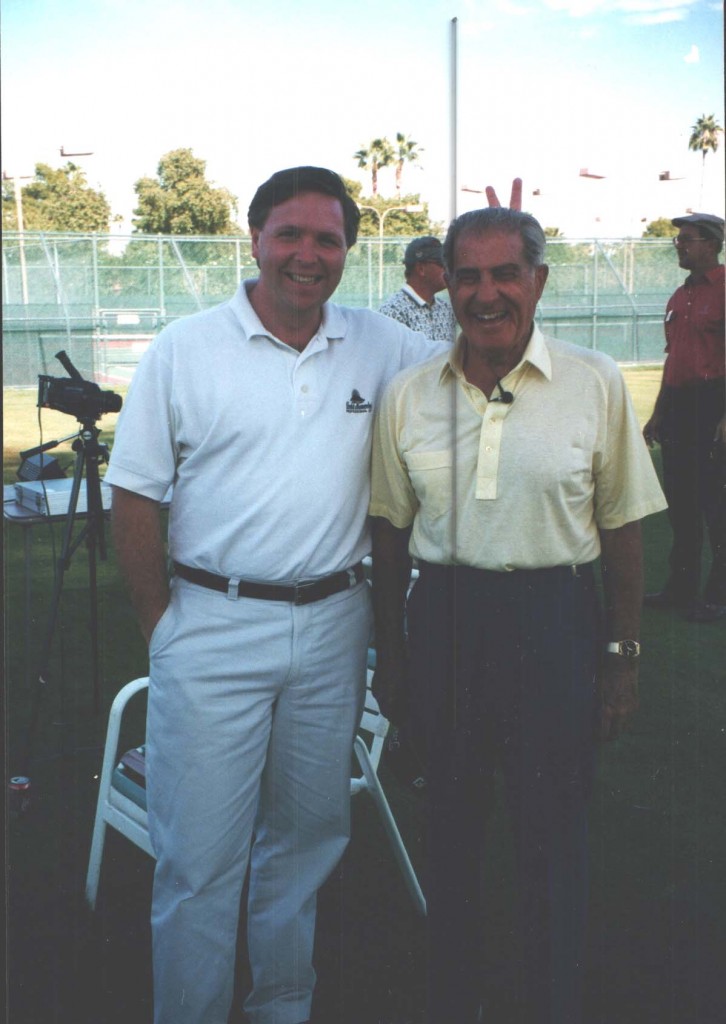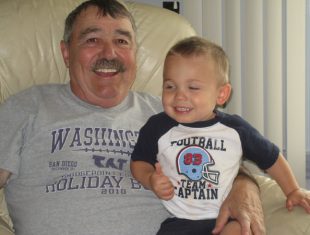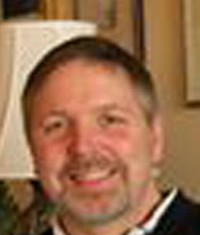JOE PERDUE AND MANUEL DE LA TORRE, 1999
By Joe Perdue
PGA Professional / Owner
Hidden Meadows Golf Course
While I was watching the food show “Chopped” and scrolling through Facebook last night, I came across a post from PGA Tour Professional Ted Purdy which immediately brought tears to my eyes. Manuel de la Torre, whom I consider the best golf instructor on the planet, and one of the finest gentlemen that I have ever had the privilege to meet, is entering hospice care today, and his time is very short.
I spent the rest of the evening reflecting on how I had met Manuel, which seems like it was forever ago, while at the same time it’s as fresh in my mind as if it were yesterday.
Where does time go?
Six years after meeting him for the first time, I attended one of his three day teaching seminars. That was in the fall of 1999. The seminar was at Moon Valley Country Club, owned at the time by Karsten Manufacturing, and it took place over a Saturday, Sunday and Monday. Around noon that Monday, news got around that Payne Stewart had been on a plane that crashed. Speculation was that Tom Lehman was on the same plane. But things were sketchy, the Internet wasn’t what it is today, and the remainder of the seminar was somber. How Manuel was able to keep 40+ golf professional’s focused on teaching that afternoon is a tribute to his ability to teach teachers how to teach.
Fast forward six months. I took a job in Menominee, Michigan, about three hours north of Milwaukee Country Club, where Manuel had been the golf professional and was now the teaching professional. About once a year I would get down to spend some time on the practice range with him, and I would stick around afterwards to watch him teach.
I lost touch with Manuel in 2009. Life took me back to Washington state for 10 months, then my partner and I bought a golf course in Maine. I never seemed to be able to carve out the time to attend another of Manuel’s seminars. I had heard that he’d had a stroke a couple of years ago, but he had recovered enough to keep teaching. Even at 93 years old, Manuel could outlast anybody on the driving range when he was teaching.
Manuel worked with some outstanding golfers. Carol Mann, who won the U.S. Women’s Open, and Tommy Aaron, who won The Master’s, were two of Manuel’s students. Ted Purdy was another. Manuel was also an excellent player in his day, winning the Wisconsin State Open and Wisconsin PGA Championship numerous times, as well as the National Open Senior Classic in 1973. I believe that is the equivalent of what is now the U.S. Senior Open.
Below is a story I wrote several years ago about Manuel and his teaching method. Now seems an appropriate time to share it again. Thank you, Manuel, for teaching me how to teach golf, and for teaching me how to be a better person. I am forever grateful, and I treasure the memories of the times I was able to spend with you. My thoughts and prayers go to you and your family during this difficult time.
By Joe Perdue
December, 1999
Over the past couple of months, I have unintentionally become part of a group that one could liken to the infamous “Deadheads.” I came to this realization on my way to Phoenix recently as I was headed to Moon Valley Country Club to listen to arguably the greatest golf instructor alive.
Fortunately, I wasn’t traveling by way of a VW bus, although it might have been appropriate after what happened while I was waiting to check into my motel. While I was in line I noticed a couple of guys standing in the lobby, and I was thinking to myself, “I think I’d want these guys on my side if a brawl breaks out.” In fact, I was looking for the fastest escape route from the lobby just in case some idiot made a rude comment about their lack of a regular trip to the barber.
It was only when one of the guys told the desk clerk they would need a total of four rooms to accommodate their entire group that I noticed “Hell’s Angels” on the back of their leather jackets.
“Just think of how this will add to the experience of your trip,” was Ken Kubitz’s response when I asked him about the safety features of the motel. Kubitz, a teaching professional at both Bremerton’s Gold Mountain and Tacoma’s Lake Spanaway golf courses, has told me about his travels of the continental 48 in a Volkswagen bug, and I’m sure his life experiences include both Jerry Garcia and the before mentioned motel guests. No wonder he didn’t seem to share my concerns.
It’s because of Ken that I was in Phoenix and had become a member of this following. He and I first met in Palm Springs in the winter of 1993 at a PGA teaching seminar. At the time, I was just looking for a way to get some sun, play a couple of rounds of golf at PGA West, and get some required education points to maintain my standing with the PGA of America. Ken told me to “pay attention” to the keynote speaker, that he was one of the best in the business and I might learn something.
The seminar was interesting, as anything related to golf is for me. But at the time I didn’t truly appreciate exactly who it was I was watching. Theories on the golf swing are many and varied, and although the ideas he presented were different in many respects from how I learned to play and teach, they seemed much too simple for me to buy into.
Since then, around October every year, Ken would mention to me that he was going to take a road trip down south, which included a few days stop in Phoenix. “A bunch of us who teach this concept are getting together,” Ken would tell me, “Why don’t you come on down?”
I never took him up on his offer, which,along with quitting college, are two of the dumber moves I’ve made in my life.
This past summer Ken somehow made arrangements for his mentor to come to Kitsap County. When he asked me if I’d like to be included in this special gathering, I was smart enough to accept his invitation in a heartbeat.
I would liken my experience that weekend at Trophy Lake to that of Michael Murphy in the classic book “Golf In The Kingdom,” where he met the mystical Scottish golf professional Shivas Irons. And in later speaking with a couple of the other attendees, I found that I wasn’t the only one walking around in a euphoric fog after having had the privilege of listening to and working with Manuel de la Torre.
Golf Professional Emeritus at Milwaukee Country Club in Wisconsin, de la Torre’s teachings originate from those of his father, Angel de la Torre, and the famous British professional Ernest Jones.
Ernest Jones developed his teaching method while recuperating from having his left leg amputated below the knee in a World War I injury. Forced to play on just one leg, the Jones method evolved of swinging the club head with the hands and allowing all other motion to be the results of that swing, rather than the causes of it.
“I don’t like the way golf is being taught today because the emphasis is on what the body does,” says de la Torre, who played the pro circuit before turning his attention to teaching. He finished tied for third with Cary Middlecoff in the 1950 Tucson Open, behind Chandler Harper and Sam Snead. He won the 1973 U.S. Senior Open, and has won the Wisconsin State Open and PGA Medal Play championship five times each.
“My contention is that no two people ever move the same way. So when you see a golfer, say Nicklaus, do something with his left heel, or somebody else do something with their right elbow, it doesn’t mean that everyone has to do that. Everybody has to be their own self in everything they do. Golf is no different.
“You can do the same thing everybody does, but you have to look like yourself while you’re doing it. And unless you have that intent, you’re going to have a lot of problems,” de la Torre adds.
Just pick up the latest issue of Golf Digest and you’ll see exactly what de la Torre is talking about. Most, if not all, instruction pieces emphasize body positions during the swing.
“The emphasis on the Ernest Jones system is on the golf club, and that’s basically the difference. Those of us who are teaching this system are primarily concerned only with what you do with this golf club. I don’t care what I look like, as long as my body is responding to the motion which I am producing with that golf club. And that response is going to be different for every single human being,” stresses de la Torre.
Much discussion took place regarding the proper grip, set-up and alignment, the three things that have to be correct every single time you prepare to make a swing if you want to have consistent ball flight.
“Those things have to be done to perfection, because if any of those things have changed, your swing can change, the ball flight will change, and you will always think there’s something wrong with your swing,” said de la Torre.
Getting ready to make the swing is the tough part, while the actual motion of the swing is the easiest. “Make sure your body is in a responsive state. Then, you must swing the club with two hands,” emphasizes de la Torre. “Swing the club with the hands over your right shoulder, one motion.
“From there the responsibility shifts to your arms, and your arms handle everything from that point until the end of the swing. And that’s all there is to it. There is no more, and no less.”
The reason people run into problems is because they try to help the club hit the golf ball. “We don’t hit the golf ball, we make golf swings. The ball is the club’s responsibility. It responds to the clubs motion, not to you. It’s the golfer’s job to produce the finest golf swing that you are capable of.
“90% or maybe even more, of the shots that are missed are caused because you are trying to hit the golf ball with the club head. You don’t hit golf balls. The golf ball is propelled by a moving object, which is the golf club,” said de la Torre.
The concept of swinging the club and moving the ball from point A to point B is one thing, but there’s much more when it comes to playing the game of golf. Mental attitude, course management, practice and having a solid short game are all intricate parts to becoming a successful player, points that don’t go unnoticed by de la Torre. And all are points that will undoubtedly be covered in his book, which is due out sometime in the near future.
There is no way to absorb over 50 years of golf and teaching experience in just a couple of days, so when this group gets together again next October, you can bet I’ll be making my annual pilgrimage to Phoenix, Hell’s Angels not withstanding!




